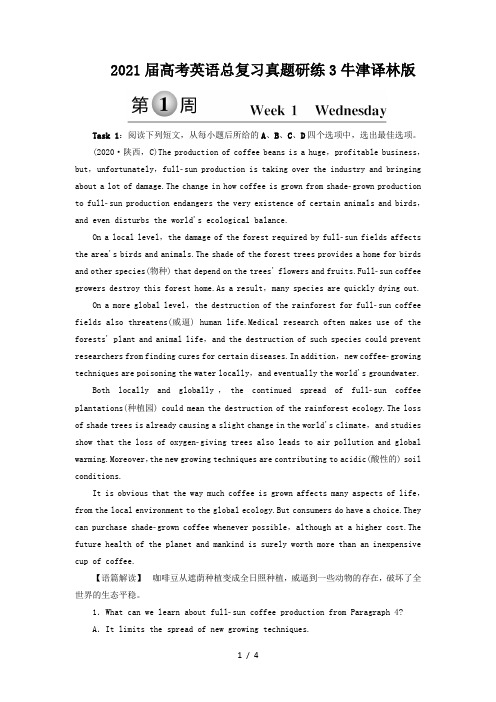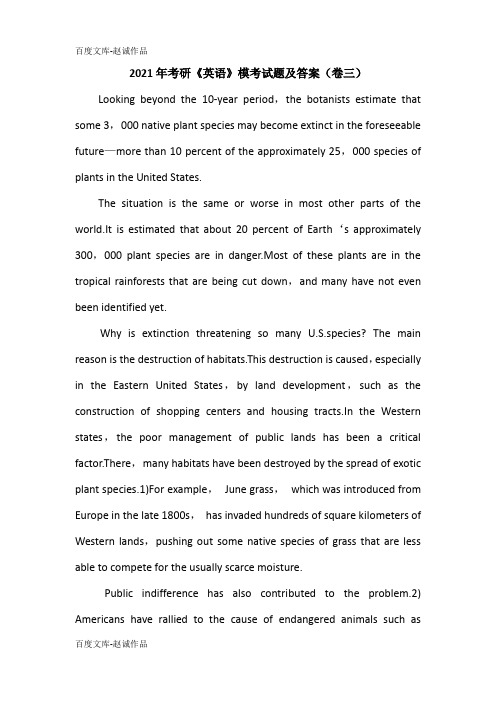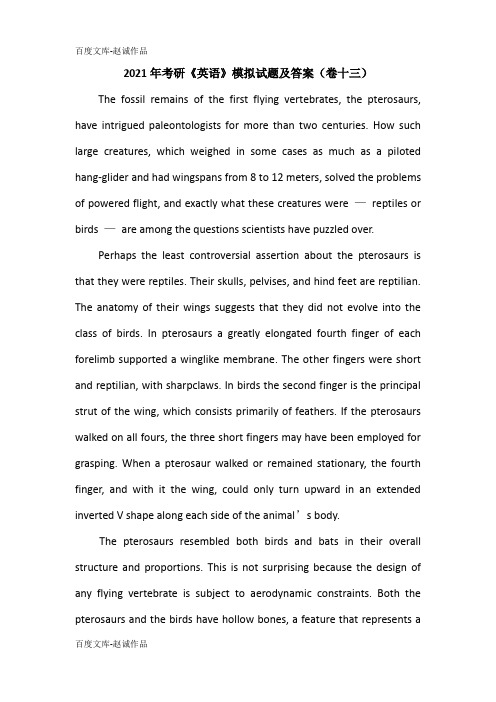2021考研英语讲义 题源报刊原文+练习·Lesson3
2021高三统考外研英语一轮复习讲义:Book3Module4SandstormsinAsia(含解

Book 3 Module 4 Sandstorms in Asia[«起第背诵经典的]1 . Sandstorms have become so widespread that they have severely affected people's daily life and held back econo mic growth.沙尘暴变得如此广泛,已经严重影响到人们的日常生活以及经济发展。
2. Some proper measureappear_to一.have__been__adopted to deal with the serious problem.人们似乎已经采取了一些适当的措施来处理这个严重的问题。
3. There is no denying the fact that sandstorms have become a seriousproblem with which we are confronted.无可否认的事实是沙尘暴已经成了我们面临的一个严重问题。
4. To_have_been _caught in a san dstorm was so frighte ning that no one wan ted to experie nee it.遭遇沙尘暴是如此可怕,没人愿意经历。
自主排查夯基固本◎重点单词I 核心单词(l) frightening (adj.)吓人的;可怕的—frighten (v.)使惊吓;惊恐—frightened (adj.)害怕的;受惊吓的—fright (n.)惊吓(2) process nJ进程;过程(vt.)处理;加工⑶forecast (vt.)预报;预告(n.)预测;预报;预示⑷Strength (n.)力量;力气—strengthen Vt.)加强strong (adj.)坚强的;强壮的—strongly (adv.)坚强地(5) cycle(vi.)骑自行车—bicycle (n.)自行车—cyclist (n.)骑自行车(脚踏车)的人(6) chemical (n.)化学药品—chemistry (n.)化学—chemist (n.)化学家;药剂师(7) environment (n.)环境—environmental (adj.)环境的(8) pollution (n.)污染—pollute (vt.)污染(9) recycle (v.)重新利用;再循环(10) concerned (adj.)关心的;担心的—concern (n.& v .)关心;担心—concerning (prep.)关于(11) evidence (n.)根据;证明—evident (adj.)明显的;显然的(12) major (adj.)主要的;多数的(vi.)主修—majority (n.)大多数(13) urgent (adj.)紧急的—urge (vt.)催促;极力主张(14) complain (vi.)抱怨;发牢骚—complaint (n.)抱怨(15) protection (n.)保护—protect (vt.)保护n 阅读单词(1)sa ndstorm n.)沙尘暴⑵inland (adj.)内地的;内陆的(3) mass (adj.)大量的;大规模的(4) campaig n (n.)战役;活动(5) d une (n.)沙丘(6) desertification (n.) (土地的)沙漠化—desert n.)沙漠(7) citize n (n.) 公民;市民(8) dust (n.)沙尘;灰尘—dusty (adj.)布满灰尘的(9) mask (n.)面罩(10) atmosphere n.)大气;大气层(11) melt (vi.)融化(12) coastal (adj.)沿海的—coast (n.)海岸(13 )nu tshell (n.) 坚果壳;简单的一句话(14) scary (adj.)恐怖的;吓人的(15) absolutely (adv.)绝对地;完全地—absolute (adj.)绝对的;完全的语境活用[单句语法填空]1. Going into hospital can be very _______ (frighten) for a child.答案:frightening2. ______________________________________________________ On the whole, these people are peacteving, law-obeying ____________________ (citizen).答案:citizens3. _______ (cycle) is good exercise. It strengthens all the muscles of the body.答案:Cycling4. ______________________________________ I am willi ng to devote myself to the _________________________________________ (en vir onment) protect ion, and ready to make my own con tributi on.答案:environmental5. The problem of ________ (pollute) arises along with the rapid development of in dustry.答案:pollution6. __________________________________________________ A lot of the plastics that carmakers are using cannot _______________________ (recycle).答案:be recycled7. Everybody is ________ (concern) about the future of his country.答案:concerned8. ____________________________ The American couple (complain) about the high cost of visitingEurope.答案:complained9. ________________________________________________________ The new system is very complicated, but I will try to explain it ____________________ a nu tshell.答案:in10. He replied that this was ________ (absolute) impossible.答案:absolutely1. -tion结尾的名词集锦①desertificatio n (土地的)沙漠化②pollution污染③protecti on 保护④application 申请⑤competiti on 竞争⑥descripti on 描述2. fore-作前缀的词汇集锦①forecast vt.预报;预告②forearm n.前臂③forehead n.前额④forek no wledge n.预知⑤forema n n. 领班,工头⑥foresight n.先见之明,预见,深谋远虑⑦foretaste n.预先的体验;预示⑧foretell v.预言,预知3. “着急”家族①urge ntadj.紧急的②impatie nt adj.着急的,没耐心的③an xious adj.焦急的O重点短语1. cut_down 砍倒;削减2. be_caught_in 突然遭遇(风暴等)3. wake_up_to 醒来面对;意识到4. one after another 一个接一个地5. ................................................... have_a_bad_effect_on 对有坏影响6. take in 吸收;收养;收留7. give out 放出;发出;用完;耗尽8. can't help but 不得不9. in a nutshell 简言之;概括地讲10. look through 浏览语境活用[选词填空]cut dow n, take in, wake up to, give out, be caught in, in a nu tshell1. ____________________ Brett's always homeless animals.答案:taking in2. _____________________________________ The police are doing all they can to _________________________________________ the accidents.答案:cut down3. My money was beg inning to _______ and there were no jobs to be found.答案:give out4. I _________ the rain and my suit has been ruined.答案:was caught in5. ____________________ He has n't yet the serious ness of the situati on.答案:woken up to6. To put it _______ , we're bankrupt 破产的).答案:in a nutshell联患枳累1. effect的短语搭配①have an effect on/upon … 对 . 有(坏)影响②come/go i nto effect开始生效;开始实施③bring/put/carry ... into effect 实行;使生效④in effect有效;在实施中;实际上⑤take effect生效,起作用2. give的短语搭配①give out放出;发出;用完,耗尽②give in屈服,让步③give off发出④give away捐赠;泄露;分送;送掉⑤give up放弃3. “ be +过去分词+ in ”结构小结①be caught in突然遭遇(风暴等)②be absorbed in专注于某事③be dressed in 穿着④be en gaged in忙于某事⑤be lost in陷入 ..❸常用句式答案:l.have never read a more moving one 2.lf not直击重点突破考点L ---------------------- 单词点津------------ 」1.strength n.力量;力气;长处;优势;强度;坚强(P32)先练(1) 单句语法填空①He has n't got eno ugh stre ngth ______ (remove) that stone.②He hoped ________ (strength) the position of the sciences in the leadinguni versities.答案:① to remove ② to strengthen(2) 单句改错Before going into the Asian market, they thought carefully of their strength and weak nesses.答案:strength^strengths(3) 单句写作①He pushed agai nst the rock ____________________ .他用全力推那块石头。
2021年硕士入学考试英语阅读真题附答案详解-TEXT3_3

2021年硕士入学考试英语阅读真题附答案详解:TEXT32000 Passage 3When a new movement in art attains a certain fashion, it is advisable to find out what its advocates are aiming at, for, however farfetched and unreasonable their principles may seem today, it is possible that in years to come they may be regarded as normal. With regard to Futurist poetry, however, the case is rather difficult, for whatever Futurist poetry may be — even admitting that the theory on which it is based may be right — it can hardly be classed as Literature.This, in brief, is what the Futurist says: for a century, past conditions of life have been conditionally speeding up, till now we live in a world of noise and violence and speed. Consequently, our feelings, thoughts and emotions have undergone a corresponding change. This speeding up of life, says the Futurist, requires a new form of expression. We must speed up our literature too, if we want to interpret modern stress. We must pour out a large stream of essential words, unhampered by stops, or qualifying adjectives, or finite verbs. Instead of describing sounds we must make up words that imitatethem; we must use many sizes of type and different colored inks on the same page, and shorten or lengthen words at will.Certainly their descriptions of battles are confused. But it is a little upsetting to read in the explanatory notes that a certain line describes a fight between a Turkish and a Bulgarian officer on a bridge off which they both fall into the river — and then to find that the line consists of the noise of their falling and the weights of the officers: "Pluff! Pluff!A hundred and eighty-five kilograms."This, though it fulfills the laws and requirements of Futurist poetry, can hardly be classed as Literature. All the same, no thinking man can refuse to accept their first proposition: that a great change in our emotional life calls for a change of expression. The whole question is really this: have we essentially changed?59. This passage is mainly________.[A] a survey of new approaches to art[B] a review of Futurist poetry[C] about merits of the Futurist movement[D] about laws and requirements of literature60. When a novel literary idea appears, people should try to________.[A] determine its purposes[B] ignore its flaws[C] follow the new fashions[D] accept the principles61. Futurists claim that we must________.[A] increase the production of literature[B] use poetry to relieve modern stress[C] develop new modes of expression[D] avoid using adjectives and verbs62. The author believes that Futurist poetry is________.[A] based on reasonable principles[B] new and acceptable to ordinary people[C] indicative of basic change in human nature[D] more of a transient phenomenon than literature难句解析:①When a new movement in art attains a certain fashion, it is advisable to find out what its advocates are aiming at, for, however farfetched and unreasonable their principles may seem today, it is possible that in years to come they may be regarded as normal.▲该句是一个因果关系的并列句,表示结果的部分是When a new movement in art attains a certain fashion, it is advisable tofind out what its advocates are aiming at,表示原因的部分是for it is possible that in years to come they may be regarded as normal。
专业型硕士研究生英语课文讲义unit-3

2021/8/6
7
Paragraph 2
• As for the landscape, it is enormously varied and spectacular. In the west there are the Rocky Mountains and the Sierra Nevada, with their snow-capped peaks, and in the east the wild, forestcovered Appalachians, whose highest summit is nearly 7000 feet. There is an abundance of waterfall, gentle rivers, lakes that are small and intimate or vast like the Great Lakes, Lake Superior is the20l2a1/r8/g6 est freshwater lake in the world16
2021/8/6
28
Paragraph 5
• Many Americans, young and old, prefer camping in vehicles, called campers. There are many different kinds, from the extremely luxurious to the convertible pick-up truck. There are monster campers with every imaginable luxury, from deep freezes and microwave ovens, to plush carpets and color television sets. They can accommodate four people comfortably, and they do not necessarily belong to rich people.
2021届高考英语总复习真题研练3牛津译林版

2021届高考英语总复习真题研练3牛津译林版Task 1:阅读下列短文,从每小题后所给的A、B、C、D四个选项中,选出最佳选项。
(2020·陕西,C)The production of coffee beans is a huge,profitable business,but,unfortunately,fullsun production is taking over the industry and bringing about a lot of damage.The change in h ow coffee is grown from shadegrown production to fullsun production endangers the very existence of certain animals and birds,and even disturbs the world's ecological balance.On a local level,the damage of the forest required by fullsun fields affects the area's birds and animals.The shade of the forest trees provides a home for birds and other species(物种) that depend on the trees' flowers and fruits.Fullsun coffee growers destroy this forest home.As a result,many species are quickly dying out.On a more global level,the destruction of the rainforest for fullsun coffee fields also threatens(威逼) human life.Medical research often makes use of the forests' plant and animal life,and the destruction of such species could prevent researchers from finding cures for certain diseases.In addition,new coffeegrowing techniques are poisoning the water locally,and eventually the world's groundwater.Both locally and globally,the continued spread of fullsun coffee plantations(种植园) could mean the destruction of the rainforest ecology.The loss of shade trees is already causing a slight change in the world's climate,and studies show that the loss of oxygengiving trees also leads to air pollution and global warming.Moreover,the new growing techniques are contributing to acidic(酸性的) soil conditions.It is obvious that the way much coffee is grown affects many aspects of life,from the local environment to the global ecology.But consumers do have a choice.They can purchase shadegrown coffee whenever possible,although at a higher cost.The future health of the planet and mankind is surely worth more than an inexpensive cup of coffee.【语篇解读】咖啡豆从遮荫种植变成全日照种植,威逼到一些动物的存在,破坏了全世界的生态平稳。
2021年考研《英语》模考试题及答案(卷三)

2021年考研《英语》模考试题及答案(卷三)Looking beyond the 10-year period,the botanists estimate that some 3,000 native plant species may become extinct in the foreseeable future—more than 10 percent of the approximately 25,000 species of plants in the United States.The situation is the same or worse in most other parts of the world.It is estimated that about 20 percent of Earth‘s approximately 300,000 plant species are in danger.Most of these plants are in the tropical rainforests that are being cut down,and many have not even been identified yet.Why is extinction threatening so many U.S.species? The main reason is the destruction of habitats.This destruction is caused,especially in the Eastern United States,by land development,such as the construction of shopping centers and housing tracts.In the Western states,the poor management of public lands has been a critical factor.There,many habitats have been destroyed by the spread of exotic plant species.1)For example,June grass,which was introduced from Europe in the late 1800s,has invaded hundreds of square kilometers of Western lands,pushing out some native species of grass that are less able to compete for the usually scarce moisture.Public indifference has also contributed to the problem.2) Americans have rallied to the cause of endangered animals such aswhooping cranes and African elephants,but they seem unconcerned about endangered plants.Perhaps they consider wild animals to be public property,but plants are the property of the owner of the land on which they grow.The consequences of habitat destruction are often most serious in the tropics and subtropics.Those regions have a much greater number of plant species than are found in cooler climates.And many species grow in only a small area,increasing the probability of their being wiped out.It is not surprising,therefore,that nearly 75 percent of the 680 species on the most-endangered list are located in just three states and Puerto Rico.Hawaii has 21 percent;Texas,12.2 percent;Florida,10.6 percent;and Puerto Rico,10.1 percent.But nearly all of the 50 states have at least a few native plants that are among those facing extinction.Saving endangered plants is important for several reasons.Among those plants,there may be some that produce substances that could be of value in making medicines.Others might possess genetic traits that could be used to improve crop plants.We might also find that some plants are worth growing for their own sake—as food or perhaps for the oil in their seeds.But beyond such practical applications,there is a sense of loss when any species—a plant as much as an animal—disappears from the face of the Earth forever.1. In another decade,it is estimated that____.[A]more than 10 percent of the native plants in the United States may die out[B]approximately 25,000 species of plants in the United States will be extinct[C]20 percent of Earth‘s approximately 300,000 plant species will be extinct[D]20 percent of Earth‘s approximately 300,000 plant species may become extinct2. Which of the following is NOT mentioned as a cause of plant species extinction?[A]Careless introduction of foreign plant species.[B]Over-development of 1and for commercial use.[C]Public ignorance of the present situation.[D]Inappropriate governmental land protection policies.3. In what way are the public indifferent to the present situation?[A]They are still unaware of the cause of land destruction.[B]They pay too much attention to endangered animals.[C]They do not give due attention to saving endangered plants.[D]They are selfish enough to protect only their own properties.4. Plant species in the tropics and subtropics are most vulnerable in that____.[A]a greater number of plant species are found there than in coolerregions[B]many plant species grow in only a small area in these regions[C]these regions frequently become the first targets of deforestation[D]countries within these regions have a worse sense of environmental protection5. All of the following are practical considerations for protecting plant species EXCEPT____.[A]medicinal use of plant species[B]utilizing their genetic traits to develop better plant species[C]a sense of loss that some species disappear even before they are identified[D]production of food and oil for the dinner table out of them1. [A] 参阅第一段,这句话的意思是:在展望10年后的情况时植物学家们预计,在不久的将来,3 000种植物——占美国近25 000种植物的10%以上——将可能灭绝。
2021年考研《英语》模拟试题及答案(卷十三)

2021年考研《英语》模拟试题及答案(卷十三)The fossil remains of the first flying vertebrates, the pterosaurs, have intrigued paleontologists for more than two centuries. How such large creatures, which weighed in some cases as much as a piloted hang-glider and had wingspans from 8 to 12 meters, solved the problems of powered flight, and exactly what these creatures were —reptiles or birds —are among the questions scientists have puzzled over.Perhaps the least controversial assertion about the pterosaurs is that they were reptiles. Their skulls, pelvises, and hind feet are reptilian. The anatomy of their wings suggests that they did not evolve into the class of birds. In pterosaurs a greatly elongated fourth finger of each forelimb supported a winglike membrane. The other fingers were short and reptilian, with sharpclaws. In birds the second finger is the principal strut of the wing, which consists primarily of feathers. If the pterosaurs walked on all fours, the three short fingers may have been employed for grasping. When a pterosaur walked or remained stationary, the fourth finger, and with it the wing, could only turn upward in an extended inverted V shape along each side of the animal’s body.The pterosaurs resembled both birds and bats in their overall structure and proportions. This is not surprising because the design of any flying vertebrate is subject to aerodynamic constraints. Both the pterosaurs and the birds have hollow bones, a feature that represents asavings in weight. In the birds, however, these bones are reinforced more massively by internal struts.Although scales typically cover reptiles, the pterosaurs probably had hairy coats. T. H. Huxley reasoned that flying vertebrates must have been warm-blooded because flying implies a high rate of metabolism, which in turn implies a high internal temperature. Huxley speculated that a coat of hair would insulate against loss of body heat and might streamline the body to reduce drag in flight. The recent discovery of a pterosaur specimen covered in long, dense, and relatively thick hairlike fossil material was the first clear evidence that his reasoning was correct.Efforts to explain how the pterosaurs became airborne have led to suggestions that they launched themselves by jumping from cliffs, by dropping from trees, or even by rising into light winds from the crests of waves. Each hypothesis has its difficulties. The first wrongly assumes that the pterosaurs’hind feet resembled a bat’s and could serve as hooks by which the animal could hang in preparation for flight. The second hypothesis seems unlikely because large pterosaurs could not have landed in trees without damaging their wings. The third calls for high waves to channel updrafts. The wind that made such waves however, might have been too strong for the pterosaurs to control their flight once airborne.1. It can be inferred from the text that scientist now generally agreethat the[A] enormous wingspan of the pterosaurs enabled them to fly great distances.[B] structure of the skeleton of the pterosaurs suggests a close evolutionary relationship to bats.[C] fossil remains of the pterosaurs reveal how they solved the problem of powered flight.[D] pterosaurs were reptiles.2. The author views the idea that the pterosaurs became airborne by rising into light winds created by waves as[A] revolutionary.[B] unlikely.[C] unassailable.[D] probable.3. According to the text, the skeleton of a pterosaur can be distinguished from that of a bird by the[A] size of its wingspan.[B] presence of hollow spaces in its bones.[C] anatomic origin of its wing strut.[D] presence of hooklike projections on its hind feet.4. The ideas attributed to T. H. Huxley in the text suggest that he would most likely agree with which of the following statements?[A] An animal’s brain size has little bearing on its ability to master complex behaviors.[B] An animal’s appearance is often influenced by environmental requirements and physical capabilities.[C] Animals within a given family group are unlikely to change their appearance dramatically over a period of time.[D] The origin of flight in vertebrates was an accidental development rather than the outcome of specialization or adaptation.5. Which of the following best describes the organization of the last paragraph of the text?[A] New evidence is introduced to support a traditional point of view.[B] Three explanations for a phenomenon are presented and each is disputed by means of specific information.[C] Three hypotheses are outlined and evidence supporting each is given.[D] Recent discoveries are described and their implications for future study are projected.[答案与考点解析]1. 【答案】D【考点解析】这是一道审题定位题型。
考研英语阅读长难句lesson3

阅读语法长难句Lesson3
冒号和破折号的出现,意味着同位语的出现 It usually leads to no good——drinking, drugs and casual sex.
微博/公众号:章晋林老师
阅读语法长难句Lesson3
冒号和破折号的出现,意味着同位语的出现 It usually leads to no good——drinking, drugs and casual sex(同位 语). 同位语取其一,在情感色彩明确的情况下,抽象化理解即可。
需要利用冒号之后内容): instead of thinking of it as something that can
be measured by moment-to-moment joy, we should consider being happy as a past-tense condition. Q:Jennifer Senior suggests in her article that raising a child can bring____ [A] temporary delight [B] enjoyment in progress [C] happiness in retrospect [D] lasting reward
核心:PDA法案判定如果因为员工怀孕而开除她是非法的
微博/公众号:章晋林老师
阅读语法长难句Lesson3
A,B,C A+C完整,B无视 Amateurs, on the other hand, have continued to pursue local studies in the old way. On the other hand不影响A+C的语法完整性
2021年考研英语(一)真题第3篇

2021年考研英语(一)真题第3篇 Alternatives toConventional Paid MediaThe rough guide to marketing success used to be that you got what you paid for.过去,市场营销的成功诀窍简而言之就是一分钱一分货。
No longer. While traditional "paid" media-such as television commercials and print advertisements-still play a major role, companies today can exploit many alternative forms of media.然而时过境迁。
虽然传统的"付费"媒介,比如电视和广播广告、平面广告和路边广告牌等,仍然扮演着重要角色,但企业如今还可以利用许多其他形式的媒介。
Consumers passionate about a product may create "earned" media by willingly promoting it to friends and a company may leverage "owned" media by sending e-mail alerts about products and sales to customers registered with its Web site.痴迷于某种产品的消费者,可能会乐意将之推荐给朋友,从而为企业创造因产品的优良品质带来的"无偿"媒介。
企业还可以利用"自有"媒介,通过邮件向其网站的注册用户发送产品和销售提示。
The way consumers now approach the process of making purchase decisions means that marketing's impact stems from a broad range of factors beyond conventional paid media.事实上,如今消费者作出购买决定的方式,意味着市场营销的影响力来自于传统付费媒介之外的广泛因素。
- 1、下载文档前请自行甄别文档内容的完整性,平台不提供额外的编辑、内容补充、找答案等附加服务。
- 2、"仅部分预览"的文档,不可在线预览部分如存在完整性等问题,可反馈申请退款(可完整预览的文档不适用该条件!)。
- 3、如文档侵犯您的权益,请联系客服反馈,我们会尽快为您处理(人工客服工作时间:9:00-18:30)。
21考研题源报刊泛读精读课Lesson3·Greenhouse gases are depriving our oceans of oxygenMarine biologists will tell you that fish species such as tuna and swordfish, known as the deep-water divers of the ocean for hunting at depths of 200 metres, are today repeatedly coming to surface view.The reason for the behavioural quirk is that warming sea temperatures have zapped oxygen out of waters even far out to sea, making it difficult for the predators to breathe — let alone hunt — in deep water. As the planet’s atmosphere traps more heat, so the oceans get warmer.“If you think ocean warming, think rising sea levels, deaths of coral reefs, and the ocean acidifying,” Peter Thomson, the UN Special Envoy for the Ocean, told UN Environment. “This will make it harder for ocean-based lifeforms like shellfish to survive in the ocean.”In dialogues about ocean issues, the effects of greenhouse gases, such as ground-level ozone and carbon dioxide, haven’t received nearly as much attention as plastic, largely because they aren’t visible. But oxygen is as essential for the ocean as it is on land. And while it can vary at different depths, rising sea temperatures have caused deep ocean areas already low in oxygen, to deoxygenate further, changing habitats for underwater life.A report published recently by the World Meteorological Organization revealed that more than 90 percent of the energy trapped by greenhouse gases goes into the oceans. Last year saw new highs of ocean temperature in the top 700 metres and 2,000 metres of water, surpassing the previous record set in 2017. Thomson, who was given the mandate to push for conservation and the sustainable use of the oceans by UN Secretary-General António Guterres in 2017, says that we should all care about those findings, even if we live nowhere near a coast, because “every second breath of oxygen that we take comes from oxygen produced by life in the ocean.”Greenhouse gases are the main source of air pollution and include carbon dioxide, methane, and nitrous oxide. While some gases are produced through natural processes like animal and plant respiration, human activity such as fossil fuel burning, livestock rearing and vehicle emissions have increased their quantity.UN Environment says that pollution from land-based sources is of particular concern for the oceans because of forms of reactive nitrogen—which includes nitrous oxide (a potent greenhouse gas). Nitrogen deposition from atmospheric emissions and runoff can trigger toxic algal blooms that are harmful to marine life and cause oxygen deficiency in the ocean, which in turn, can kill fish, crabs, oysters and other aquatic animals.“This global problem, compared to the issue of plastics pollution, is typically ‘unseen’ but no less important, as it adds further to nutrient pollution from waste-water, agricultural and other industrial runoff that is carried to the marine environment by rivers,” said Christopher Cox, programme management officer on marine pollution at UN Environment.Oceans are by far the largest carbon sink on the planet, storing some 30 per cent of carbon dioxide and 93 per cent of all greenhouse gases. But through increased human activity they are struggling to keep up. That is why civil society, governments and businesses must work together to cut back on pollutants.“The ocean has been a buffer to extreme climate change, but we are pushing its boundaries,” Gabriel Grimsditch, programme management officer for marine ecosystems at UN Environment said. “Ocean warming, ocean acidification and sea-level rise are all consequences of a system that is polluting the world and putting life on earth, and under water, at risk.”On plastic becoming a flag-bearer for ocean action, Thomson thinks it is “really useful” because it has brought about a lot of public engagement with the blue ecosystem such as the ban of single-use plastics in some countries. However, a much greater battle needs to be fought to get below the 2°C target for global warming set by the Paris Agreement, if we are to preserve the vibrancy of ocean life.Q1:Deep-water fishes are coming to the surface because of______A. their fear of dangerous predatorsB. their struggle with warmer waterC. their desperate need for oxygenD. their fight against global warmingQ2: What can be learned from the 2nd and 3rd paragraphs?A. People have largely ignored the oceanic deoxygenationB. Underwater habitats are no longer suitable for creaturesC. Deaths of coral reefs are responsible for oceanic deoxygenationD. Oceanic deoxygenation is not as serious as plastic crisis(混淆选项)Q3: According to UN Environment, nitrous oxide may serve as_____A. a component of the toxic algal bloomsB. a factor of oceanic oxygen deficiencyC. a trigger of aquatic animals’ extinctionD. a cause of greenhouse gases’ depositionQ4: To maintain the oceanic carbon sink, we may need to_____A. eliminate human activityB. curb greenhouse gases emissionsC. generate collective effortsD. Civilize the whole societyQ5: which of the following is the best title for the passage?A. Oceanic crisis: time to wipe out nitrogenB. Ocean warming: a serious threat to aquatic animalsC. Greenhouse gases: depriving ocean of oxygenD. Greenhouse gases: no less harmful than plastics。
